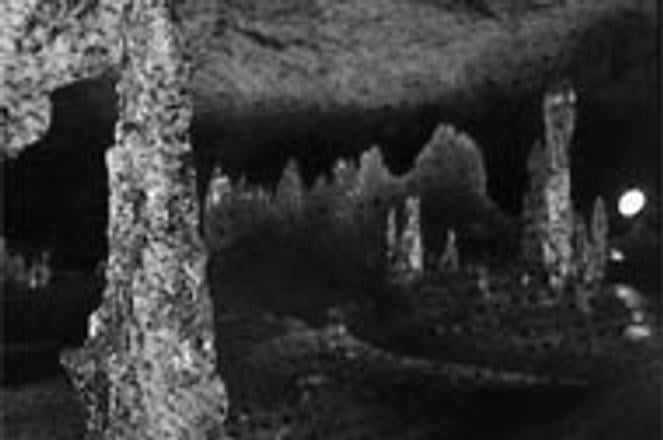A magical underworld. The Dobšiná ice cave dazzles visitors with its unique ice formations.Courtesy of Rožňava Information Center
Morning comes cold in the closed-in Hlniec river valley tucked east of the Low Tatras. There is a stillness to the dense tree-lined slopes that curve their way deeper into Slovenský Raj, Slovakia's Paradise.
But before entering this playful natural park, the wide road with loose stones from Poprad to Dobšina, flattens out after a steep descent away from the mountains into a tourist trap of sorts. Somewhere in the trees is the entrance to the famous Dobšiná ice cave.
To suit the many visitors seeking the cold underground, numerous tourist-like buildings lay scattered beside the turn-off that leads to the cave. Perched atop a slanting parking lot is a wooden non-stop restaurant serving bean soup, hot dogs and steamy but watery tea on a covered porch.
Across the way is a hotel on a hill that looks like it might slide into the road at any minute. An old rusty rail steam engine sits on an equally rusty track next to the river.
A painted wooden map shows the trail to the cave's entrance to be deceivingly near. Instead it is a tiresome two kilometers up a rutted road, where beautiful wooden huts sometimes peek out behind branches. There is some reward in the journey as expectations grow with each step. The earth outside is so known, seen every day, perhaps even under-appreciated, but the world underneath is as foreign as another planet.
After a final push up a fifty degree angled slope, the cave's entrance is reached. A newly constructed, neatly kept wood-covered patio with a giant bear painted colorfully on the wall seats visitors as they wait their turn for the tour below.
A sign, mocking foreigners, in Slovak reads: tickets cost 25 Sk if you ask in Slovak, but 50 Sk if you ask in a foreign language. To take pictures it costs another 50 Sk. Tours are given in Slovak but can be arranged in German or English if there is a large enough group.
To the ice
When assembled, groups of 20 to 40 people accompany a guide through an iron door into the mysterious ice cave. Formed 7,000 to 9,000 years ago under the wet limestone that covers Slovenský Raj, a subterranean shift buried the rock that had been carved for thousands of years by glacial rivers.
The cave has been sheltered from above ground temperatures ever since. Indeed, the cave's average temperature is minus one degree Celsius (30 degrees Fahrenheit), keeping a 98 percent relative humidity. All this adds up to a perfect place for ice to settle and form.
In 1870 Eugene Ruffini, a Hungarian naturalist, discovered the cave whose 25-meter thick floor holds an estimated 145,000 cubic meters of ice. In 1887 Doböina was the first cave in Europe to be fitted with electrical lighting.
Descending down the sometimes slippery steps, the cave's icy breath instantly chills your bones. Sound dances strangely from top to bottom of the chute, penetrating deeper into the ice's layers.
The walls are slickly smooth cold to the touch and massive. Feeling, seeing and pondering the weight of frozen water carved into giant halls and narrow tunnels is an exhilarating experience.
Fragile stalactites creep upwards toward the ceiling, formed for countless years by countless droplets.
And what strange shapes they take: crude beings frozen in time, narrow towers reaching forever up, and thick pillars seemingly rooted to the earth's center.
The false light creates striped blue patterns on the icy walls. In the final grand hall a city of ice sculptures converge from the ceiling stretching to meet gravity. Broken icicles sprinkle like broken glass.
The tour is short, lasting only about twenty minutes, leaving a yearning to explore more below. But when the sun is again felt and the sogginess leaves the bones, the world below recedes from memory and what is known - is again embraced.


